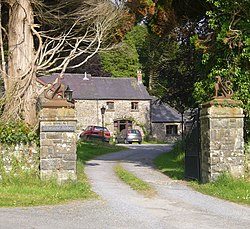Whitland Abbey
| Whitland Cistercian Abbey | |
|---|---|
 Whitland Abbey |
|
| location |
|
| Coordinates: | 51 ° 49'50 " N , 4 ° 36'0" W |
| Serial number according to Janauschek |
150 |
| Patronage | St. Mary |
| founding year | 1140 |
| Year of dissolution / annulment |
1539 |
| Mother monastery | Clairvaux Monastery |
| Primary Abbey | Clairvaux Monastery |
|
Daughter monasteries |
Cwmhir Abbey (1143/1176) |
Whitland Abbey ( Albalanda ; Welsh Abaty Hendy-gwyn ar Daf ) is a former Cistercian abbey near Whitland in Carmarthenshire in Wales .
history
The monastery was founded in 1140 as a subsidiary of Clairvaux Primary Abbey by the Norman Bishop Bernard von St Davids in Little Trefgarn, around 10 km north of Haverfordwest , and moved around 1151 to an area donated by John von Torrington in Whitland. It was the first Cistercian monastery in Wales, mother monastery of nine other houses, the first three of which were built after a short time and very quickly, and originally a Norman foundation. However, the abbey soon came under the control of the Prince of Deheubarth , Lord Rhys , whose son died a monk in Whitland, and assumed a decidedly Welsh character. The monastery was badly damaged in the wars with England. In the 15th century, the monastery, which had 17 grangs , is said to have counted 100 monks. The monastery escaped dissolution in 1536 by paying a considerable sum of money. In 1539, however, the monastery was dissolved. Excavations took place in 1836, around 1920 and since 1990.
3 km southwest of the former monastery, in the Trevaughan district of Whitland (Carmarthenshire), Trappist women from Stapehill Abbey in Ferndown founded Holy Cross Abbey in 1991 , sometimes also called "Whitland Abbey" because of its location - like the former monastery.
Buildings and plant
Only small remains of the monastery have survived. The cross-shaped, rectangular closed church was in the north of the complex, the enclosure south of it. The western lay wing was separated from the cloister by a monastery lane, a phenomenon not uncommon in the daughter monasteries of Clairvaux. However, the layout of the facility can be seen relatively well. The monastery chronicle Cronica Wallia has been preserved.
literature
- Anthony New: A guide to the Abbeys of England and Wales . Constable & Company, London 1985, ISBN 0-09-463520-X , pp. 449-450.
Web links
- Site of the Certosa di Firenze to the monastery
- Website of Cistercians Sheffield with a photo (english)
- Site of the new Trappistinnenklosters (English)
- Reference to the excavations ( Memento of July 27, 2008 in the Internet Archive )